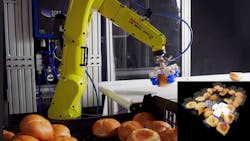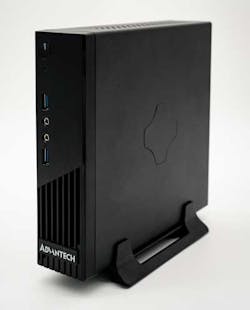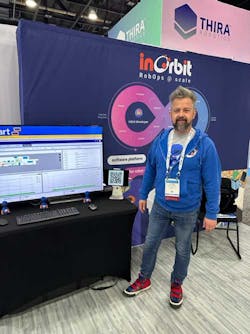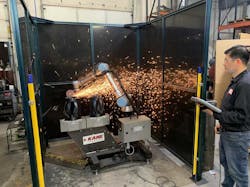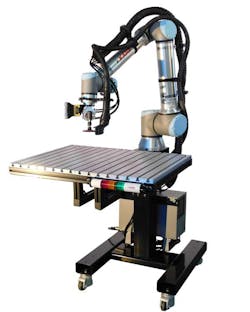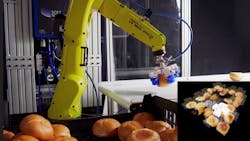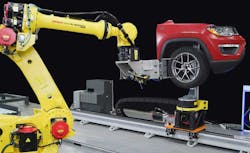Automate 2023 Showcases Process Automation: Coordinators, Orchestrators & Differentiators
This was the year end-to-end process automation made its impression as a dominant theme.
If you asked Jason Waldman what the most observable trend was at Automate 2023, his response would be something like this: “I would reckon that Rockwell Automation’s CIO would say, ‘AI, AI, AI, AI,’ but it definitely is what people are looking for.”
As Waldman, a business development manager at Advantech, continues his train of thought, one would realize that he is in effect describing the art and science of beginning-to-end process automation. “It’s not just about a robot being able to pick something up over here and put it over here,” Waldman said. “It’s also about a robot being able to do your inspection to make sure everything is okay.
“It’s about a robot being able to pivot where things should be able to go,” he continued. “It’s about being able to pick items; it’s about being able to do the visual inspections…It’s making sure robots are smart enough to where you can essentially turn them on and let them run. That, I think, is the biggest trend.”
At Automate 2023, the trend was backed by an abundance of emergent virtualizing technologies—from embedded IoT computing and AI, to material removal and calibration, to the latest in vision systems and integration software—all of which work together to scale robotic deployments. Finding a pathway to automation serves a higher ambition to scale up and enable the business to serve customer needs.
Bolster Operational Efficiency
Performance and efficiency are closely related to the goal of end-to-end solutions and services. According to Waldman, it is why Advantech, which bills itself as a provider of Industrial Internet of Things (IoT) hardware and automation technology, partners with software companies “where it makes sense” and helps customers set up equipment right out of the box.
Driving home his point, Waldman pointed to the scalable Valor Mini Workstation. There are three aspects that distinguish the solution, he said. Firstly, the industrial PC can handle complex processes by eliminating the need for frequent recertification, reintegration and replacement associated with commercial workstations. The expected lifespan of a typical industrial PC is around 12 to 18 months, but the Valor Mini offers longevity of up to seven years, Waldman pointed out.
READ MORE: Automate 2023: A Robotics & Automation Event Organized Around Market Trends
Secondly, Walman said, customers typically can order a SKU from an existing catalog. In contrast, Advantech’s workstation sets up a unique SKU number. “We actually give the customer their own SKU number on a configuration for this workstation,” explained Waldman. “When they order it, it’s a locked revision control; they know that they will receive the same product over and over again.” Thirdly, said Waldman, Advantech provides hardware customization options, from CPUs to GPUs to DRAM SSD.
The Valor Mini Workstation measures just 2.2 × 7.9 × 7.9 in. (W × D × H) and expands Advantech’s Valor Series. A full-featured Valor Tower is slated for release later this year.
Qualitative Visual Inspections Meet Quantitative Data Insights
Where size, speed and accuracy requirements need to be maintained, human vision tends to fall short. Edge learning or AI training can enable manufacturers to maximize throughput. Cognex Corporation, an industrial machine vision company, harnesses these technologies to make vision solutions easier and more marketable to the masses, said Sean St. Peter, territory sales manager, Cognex.
Based in Natick, Mass., Cognex targets logistics and automotive (electric vehicles and battery-related technology), as well as consumer electronics markets, and strives to reach a customer base that “doesn’t have the expertise and know-how to integrate this type of system into their line,” according to St. Peter.
The imaging capabilities of the In-Sight 3800 Vision System is embedded with artificial intelligence (AI)-based edge learning technology, as well as traditional rule-based algorithms. Designed for high-speed production lines, it solves tasks with high variability, sets up in minutes with just a handful of training images and offers twice the processing speeds of previous systems.
Robot Operations at Scale
Florian Pestoni, CEO and co-founder of InOrbit, guided Machine Design through a virtual tour of the company’s multi-cloud platform. InOrbit is designed to help robot developers maximize the potential of their robots through expert guidance, advanced software and strategic industry partnerships. The software abstracts the complexity of the hardware to control the autonomous robot’s position virtually.
InOrbit uses the term “Software-Defined X” to refer to the process of controlling objects in the physical world. The collaborative, open-source system is built around three personas—engineers, operations and executives—with a focus on the engineering work of building the robotic systems that make everything work and enable operations and other infrastructure to draw benefits from the robot’s potential.
READ MORE: Gearing up at Automate 2023: Schaeffler Showcases Latest Components for Robotics
Having a platform for managing robot operations (or RobOps) can elevate robotics integration at scale. Pestoni, who co-founded the company headquartered in Mountain View, Calif., explained that InOrbit provides sightlines to robots on the shop floor through secure, real-time analytics and data collection, robot performance monitoring, incident response and root-cause analysis. “With our end-to-end orchestration capabilities, we are revolutionizing the way companies manage and optimize their robot fleets,” Pestoni said.
Eliminating Dull, Dirty, Repetitive Processes
In partnership with Applied Automation, ATI industrial Automation and FerRobotics, cobot solutions developer Kane Robotics was able to demonstrate GRIT cobots in each booth.
Kane Robotics was founded in 2019 by John Spruce, an executive and entrepreneur who is able to draw from two decades of experience leading large-scale automation projects and engineering and manufacturing services for the aerospace and defense industries.
The company developed the first cobot for composites sanding. Kane highlighted its stealth at material removal with demonstrations of its GRIT cobot solutions, including sanding off coatings, grinding welds and polishing metal finishings. These capabilities help manufacturers with removing coating and sanding surfaces for paint preparation or repairs on helicopter main rotor blades, polishing fighter jet canopies, sanding primer from machine components and deburring metal castings.
At the ATI Industrial Automation booth, for example, Kane demonstrated how the combined solutions of its GRIT-ST cobot system with ATI’s CGV grinder, Universal Robots’ UR10e cobot and 3M’s Cubitron II abrasive media work together to efficiently and safely grind welds.
The company noted that ATI’s CGV grinder has built-in compliance so the unit can compensate for irregularities in part surfaces. The grinder’s compliance force is adjustable, enabling users to make changes in real-time and CGV’s sensing data allows for process validation. Paired with Kane’s GRIT cobot system, the Kane-ATI solution works alongside humans to perform a wide variety of labor-intensive tasks, while avoiding rework and downtime.
“If a person’s doing it, we can train a cobot to do it,” said Kane Robotics COO Alan Hiken. “We’re not reinventing new processes to automate; we’re helping manufacturers move to new tools that will make them more efficient and protect their health.”
Robot Tool Center Point Calibration
In aerospace applications, where robots are tasked with riveting plane panels together, precision is critical. The robot drills in a specific location, to an exact diameter, and inserts and compresses a rivet. The tool tip’s movement needs to be set in relation to the base coordinate system and is achieved more precisely when centered around the very end of the tool or end effector. Even a slight deviation from the original reference point can mean expensive rework or scrapping entire parts.
This is where BizLink’s advintec TCP system is useful. The tool was demonstrated on a FANUC CRX cobot with an ATI tool changer. The TCP tool uses a two-channel infrared (880 nm) photoelectric laser sensor pulsed at 2 kHz to calibrate tools and fixtures electronically in up to six dimensions (three axes plus angular rotation around each axis) without touching a robot’s end-of-arm tool.
According to BizLink’s press release, the system compares the robot’s path to the way its main reference moves, records the robot’s path, identifies any variations from the original path and establishes that the robot has shifted whenever a process changes or the robot requires calibration.
Soft Grippers and AI Automate Bulk Picking
Soft Robotics showcased its automated food-picking solutions, including the mGrip modular gripping system comprised of a suite of configurable soft grippers and controllers, as well as the no-code interface mGrip AI that combines 3D vision with robotic grippers and AI software for challenging food automation scenarios. Combining 3D vision, artificial intelligence and soft grasping technologies into an easy-to-integrate, IP69K-rated solution, Soft Robotics highlighted two applications:
- Case packing sausages from bulk. 3D bin picking, sorting and orienting packaged sausages at rates of up to 24 picks per minute.
- Tray packing chicken drumsticks directly from bulk. Picking, orienting and packaging of raw poultry product from bulk at rates of up to 60 units per minute.
Realtime Visual Tracking
FANUC is known for its CNC systems and is popularly associated with bringing high-payload capacity collaborative robots to market. With its North American headquarters in Rochester Hills, Mich., the company can boast 11 cobot models for industrial applications.
FANUC recently introduced the CRX-25iA cobot with a 30kg payload capacity, and the CR-35iB cobot with a 50kg payload capacity. “We’ve seen substantial growth in the cobot space, particularly from companies that are new to robotic automation,” pointed out Eric Potter, general manager, General Industry and Automotive Segment, FANUC America.
One highlight at Automate was the FANUC R-2000iC/165F robot, which uses a FANUC iRVision 3DV sensor to locate and pick a wheel from an infeed conveyor. It detects the tilt and rotation angles of a wheel hub on a moving conveyor. A 2D sensor provides visual feedback, enabling the robot to track and load the wheel as the conveyor moves. The action eliminates the need for a stop-station operation.
READ MORE: Force Control Brings Dexterity and Sensitivity to Adaptive Robots
The robot uses FANUC’s FS-250iA Force Sensor and Force Control Software to load the tire, then retracts and waits for the conveyor to stop. Next, the robot uses 3DV to locate and remove the tire from the hub and return it to the infeed conveyor; the cycle then repeats.
Several intelligent products come into play in this demo, including FANUC’s realtime visual tracking software, Industrial PC (iPC), iRVision and Force Control. The 2D iRVision tracks the 2D target without the use of encoders and the high-speed FANUC iPC processes the information.
“A key customer benefit to this type of tracking is that it can adapt to 2D variances caused by unstable conveyors, as well as adjust to slight speed variations in real time,” noted Jennyfer Pina, material handling engineer, General Industries and Automotive Segment, FANUC America.
About the Author

Rehana Begg
Editor-in-Chief, Machine Design
As Machine Design’s content lead, Rehana Begg is tasked with elevating the voice of the design and multi-disciplinary engineer in the face of digital transformation and engineering innovation. Begg has more than 24 years of editorial experience and has spent the past decade in the trenches of industrial manufacturing, focusing on new technologies, manufacturing innovation and business. Her B2B career has taken her from corporate boardrooms to plant floors and underground mining stopes, covering everything from automation & IIoT, robotics, mechanical design and additive manufacturing to plant operations, maintenance, reliability and continuous improvement. Begg holds an MBA, a Master of Journalism degree, and a BA (Hons.) in Political Science. She is committed to lifelong learning and feeds her passion for innovation in publishing, transparent science and clear communication by attending relevant conferences and seminars/workshops.
Follow Rehana Begg via the following social media handles:
X: @rehanabegg
LinkedIn: @rehanabegg and @MachineDesign
